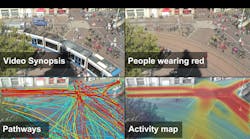By the end of 2021, the number of cameras used for surveillance across the globe was to have climbed above one billion, according to research by IHS Markit. In the United States alone the number of surveillance cameras will reach 85 million, up 10 million from the previous year. In tandem, Frost & Sullivan predicts there will be more than 26 global smart cities that meet the necessary criteria by 2025, nine of which are expected to be in the U.S.
Cities around the world are leveraging intelligent technology that enhances citizen and government engagement, reduces environmental footprint and drives more effective, data-driven decision making for day-to-day necessities. As cities continue to develop the infrastructure needed to become “smart,” video surveillance will play a significant role in increasing safety and efficiency but demands on the technology will increase.
New developments in artificial intelligence, migration to higher resolutions and frame rates are driving rapid expansion in surveillance data volumes. Add to that 4K cameras and 5G speeds reducing the latency of wireless data transmission – these new developments are pushing on-premise video surveillance to its limits.
On-camera Storage – Not So “Smart” After All
Most surveillance systems currently store their footage on camera. But while smart cities will rely heavily on video surveillance data, both current and historical, this soon will be a method of the past. On-camera storage is vulnerable from a physical security perspective as criminals can take or damage surveillance cameras to destroy incriminating evidence. Additionally, some surveillance systems have glaring protection holes, allowing the massive amounts of data being generated and stored within the device to be a top target for hackers.Recent data from Barracuda Networks indicates that 44% of global ransomware attacks in 2020 targeted municipalities. Keeping these spotty surveillance systems in place will only put these developing cities at greater risk for attack. This type of on-camera storage can also be unreliable from an accessibility perspective as it’s cumbersome to keep track of and retrieve data from a multitude of devices.
Public safety aside, there are a variety of additional smart city developments that will rely on surveillance systems to function properly, but they will need the proper connection.
Current 4G networks were designed to primarily enhance mobile data services. Unfortunately, it suffers from limitations such as poor support for simultaneous connections. Luckily, 5G will provide the necessary bandwidth for wireless connection to the cloud – something that has been holding the video surveillance industry back for years. These systems go beyond just physical cameras, they also include electronic, infrared, thermal, and proximity sensors that collect electronic signals which then are interpreted to monitor things such as traffic, weather, and energy consumption. With the implementation of 5G and as more low-cost and flexible cloud storage options become available, there is hope to overcome these issues.
Keeping an Eye On the Road From the Cloud
Traffic congestion has become a major problem in cities across the country, causing headaches for both residents and workers. Smart cities have the ability to help solve this issue through surveillance by analyzing data from local transport authorities further improving these issues both long-term and in real time. Long term, the analyzed data can uncover patterns that help reduce traffic congestion and help authorities implement data-driven road optimization.
For example, technologies such as adaptive traffic control can improve safety and significantly decrease traffic congestion levels in the most popular parts of cities. Solving these issues in real-time includes using captured data to alert both residents and first responders as to when an accident or other type of emergency has occurred. Both of these solutions require a cloud storage solution that has the ability to give users easy access to previously archived data as well as data in real-time. As a result, we’ll see more surveillance organizations leveraging hybrid cloud providers in the near future for their data storage.
Coming Together Cohesively
As smart cities continue to evolve, there will be a blend of software at different sites, oftentimes not having one standard VMS across all locations. This scenario makes it difficult for IT departments to keep up with increasing levels of video surveillance at the edge in a secure and cost-effective manner.
The missing piece to this smart city puzzle is a cohesive IT strategy. System architectures that process data through a centralized enterprise data center cannot meet the scaling and performance requirements of these smart cities due to their limitations on optionality. With advanced surveillance systems producing astronomical amounts of data daily, and that data needing to be analyzed and stored for extended periods of time, lower costs and convenience are driving continued migration to the cloud.
As smart cities begin to take shape, factors such as distributed workforces, heightened security risks and environmental concerns will only exacerbate these developments. The development of smart cities brings us steps closer to making what we used to call the future, a current reality. In 2022 and beyond we’ll see video surveillance make an accelerated move to the cloud, leveraging cost-effective and sustainable ways to store critical data at the edge.
David Friend is the CEO and Co-Founder of Wasabi.





